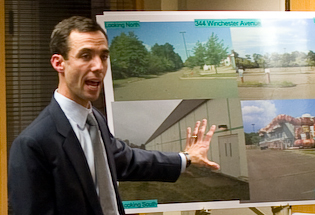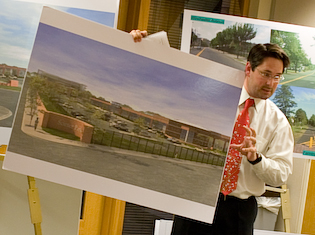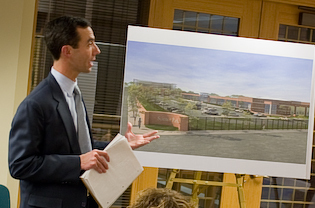 Developer Carter Winstanley plans to transform a “very large, dark” “fortress” into a glass-fronted, light-filled, bustling office center now that he has approval to rescue yet another old Winchester gun factory building.
Developer Carter Winstanley plans to transform a “very large, dark” “fortress” into a glass-fronted, light-filled, bustling office center now that he has approval to rescue yet another old Winchester gun factory building.
Winstanley (pictured) appeared in front of the City Plan Commission on Tuesday night, seeking a green light for his conversion of 344 Winchester Ave. into a modern office building. With the support of the city and Yale University, which will be the building’s principal renter, Winstanley got the approval he came for.
It was the latest step down a path of renewal of the old Winchester rifle complex at the crossroads of the Dixwell and Newhallville neighborhoods, which employed up to 18,000 factory workers in its heyday. Part of the complex was reborn as the tech-oriented Science Park, while other abandoned hulks, like 344 Winchester, awaited demolition or resuscitation.
Winstanley is an owner of Massachusetts-based Winstanley Enterprises and the developer behind the revitalization of 300 George St. and 25 Science Park, which is occupied by Yale and several tech start-ups. He’s also building a new garage at Winchester and Henry, while a separate developer is transforming the old main Winchester gun plant across the street into apartments and shops. (See coverage of his expanding domain in Science Park here, here, here, and here.)
The developer was initially hesitant Wednesday night to discuss the price tag for his new project, then predicted that the work would cost in excess of $20 million. No public funding is involved.
It’s a big undertaking in the midst of a steep economic downturn, but Winstanley said that he has always worked on “contrarian” projects.
Chrissy Bonanno, the city’s deputy economic development administrator, called the project a win for New Haven, since it will expand the tax base and bring in more jobs.
A Great Feel
Winstanley began his presentation to the board by recounting his record of recent achievements in New Haven, especially in Science Park. He said that 25 Science Park, at the corner of Winchester Avenue and Munson Street, is now 85 percent leased and home to over 700 employees. Among the high-tech tenants is Higher One, which Winstanley boasted is one of the 80 fastest-growing companies in the country.
With these successes under his belt, Winstanley said, “it would be easy to sit back and rest easy.” Yet when he stands on the sixth floor of 25 Science Park and looks north, he looks past the parking garage his company is building and sees — at 344 Winchester — a way to continue his vision even further.
Winstanley purchased 344 Winchester a little over a month ago. He plans to convert the 245,000 square foot building — a former gun factory — into a large print shop and upscale offices for Yale University. He said that he does not have any signed agreements with tenants yet, but that he has “firm commitments” on most of the building. There is still 18,000 square feet for which he has not found renters. Yale University sent a letter of endorsement to the commission.
Central to his vision is a redo of the entire facade of the building, which is now blank and windowless makes the building into, in Winstanley’s words, “a very large, dark presence.” Winstanley plans to “put as much glass on the front as possible.”
As part of an effort to create a “successful pedestrian environment,” the whole area will be landscaped. The existing fence along Winchester Avenue will be removed. The sidewalks will be redone, “so that people feel this continuum” as they walk north from 25 Science Park.
 The factory’s high ceilings will give the office building “a ton of natural light,” said Architect Chris Bockstael (pictured), from Svigals and Partners, the firm that has taken on the project. “It’s going to have a great feel to it.”
The factory’s high ceilings will give the office building “a ton of natural light,” said Architect Chris Bockstael (pictured), from Svigals and Partners, the firm that has taken on the project. “It’s going to have a great feel to it.”
David Silverstone, head of the Science Park Development Corporation, is ready for a makeover for 344 Winchester . “This building looks like a fortress,” he told the board. He praised what Winstanley had done with 25 Science Park and said that “the neighbors can’t wait for this building to receive similar treatment.”
Jobs and Taxes
“We’re very excited to build it,” Winstanley said, during a break in the meeting. He said that the office building will ring in customers for the retail and restaurant operations that will open in the parking garage now being built nearby.
Asked about the risk of taking on such a big project in a shaky economy, Winstanley said, “We’ve always taken on projects that are contrarian in nature.” He explained that his company often buys vacant properties that “other people are largely not successful with.” He mentioned 300 George St., one of his company’s projects. “A lot of people didn’t think it could be leased…This will be the same.”
Winstanley partly credited his partnerships with the city and with Yale for his past and future success.
City Plan Department Executive Director Karyn Gilvarg said that the having Yale as a tenant in the building will bring in tax revenue from the university that the city would otherwise be unable to collect, since Yale is exempt from taxes on land that it owns.
“That is kind of our solution to the tax problem with Yale. Have them rent,” she said.
Pricetag
 City Plan commissioners had a number of questions for Winstanley (pictured) and Ted DeSantos, the project’s engineer. The two men allayed all their concerns about parking and lighting, answering all questions promptly until City Plan’s Joy Ford inquired about the projected cost of the project.
City Plan commissioners had a number of questions for Winstanley (pictured) and Ted DeSantos, the project’s engineer. The two men allayed all their concerns about parking and lighting, answering all questions promptly until City Plan’s Joy Ford inquired about the projected cost of the project.
“Do I have to answer that?” Winstanley asked.
“We like to have the value of the building,” said Gilvarg.
Winstanley sighed and said, “I think it’s probably in excess of 20 million.”
Asked if that number includes the cost of any environmental remediation, Winstanley replied, “I hope so.”
An online database lists the assessed value of 344 Winchester Ave. at just over $8 million.
The board voted unanimously to approve the proposal.
Asked after the meeting why he had been reluctant to discuss the cost of the project, Winstanley said, “I don’t think it should be a public figure.”
“We’re a private company,” he continued. “We don’t usually disclose that info.”
Winstanley said that the construction on the project could begin as early as the spring and would be completed in one to three years.









Yale doesn't need to rent - they can buy. The reason they are renting is probably because if the economy keeps declining over the next decade (which is very likely, unless we stop sending most of our household savings to Saudi Arabia each year in the form of energy/oil consumption), they won't have such large commitments to maintain property.